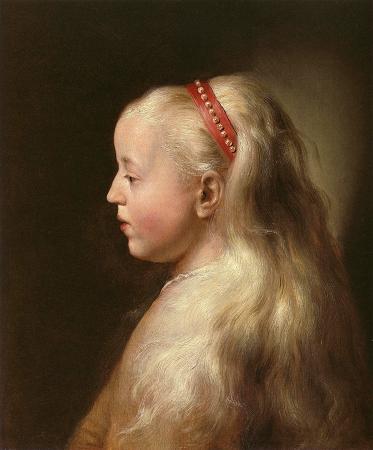Portrait of Girl. A girl is a young female human, usually a child or an adolescent. When she becomes an adult, she is described as a woman. The term girl may also be used to mean a young woman, and is sometimes used as a synonym for daughter. Girl may also be a term of endearment used by an adult, usually a woman, to designate adult female friends. The treatment and status of girls in any society is usually closely related to the status of women in that culture. In cultures where women have a low societal position, girls may be unwanted by their parents, and the state may invest less in services for girls. Girls' upbringing ranges from being relatively the same as that of boys to complete sex segregation and completely different gender roles. The English word girl first appeared during the Middle Ages between 1250 and 1300 CE and came from the Anglo-Saxon word gerle. The Anglo-Saxon word gerela meaning dress or clothing item also seems to have been used as a metonym in some sense. Until the late 1400s, the word meant a child of either sex. Girl has meant any young unmarried woman since about 1530. Its first noted meaning for sweetheart is 1648. The earliest known appearance of girl-friend is in 1892 and girl next door, meant as a teenaged female or young woman with a kind of wholesome appeal, dates only to 1961. The word girl is sometimes used to refer to an adult female, usually a younger one. This usage may be considered derogatory or disrespectful in professional or other formal contexts, just as the term boy can be considered disparaging when applied to an adult man. Hence, this usage is often deprecative. It can also be used deprecatively when used to discriminate against children. However, girl can also be a professional designation for a woman employed as a model or other public feminine representative such as a showgirl, and in such cases is not generally considered derogatory. In casual context, the word has positive uses, as evidenced by its use in titles of popular music. It has been used playfully for people acting in an energetic fashion or as a way of unifying women of all ages on the basis of their once having been girls. These positive uses mean gender rather than age. The status of girls throughout world history is closely related to the status of women in any culture. Where women enjoy a more equal status with men, girls benefit from greater attention to their needs. Girls' formal education has traditionally been considered far less important than that of boys. In Europe, exceptions were rare before the printing press and the Reformation made literacy more widespread. One notable exception to the general neglect of girls' literacy is Queen Elizabeth I. In her case, as a child she was in a precarious position as a possible heir to the throne, and her life was in fact endangered by the political scheming of other powerful members of the court. Following the execution of her mother, Anne Boleyn, Elizabeth was considered illegitimate. Her education was for the most part ignored by Henry VIII. Remarkably, Henry VIII's widow, Catherine Parr, took an interest in the high intelligence of Elizabeth, and supported the decision to provide her with an impressive education after Henry's death, starting when Elizabeth was 9. Elizabeth received an education equal to that of a prominent male aristocrat; she was educated in Latin, Greek, Spanish, French, philosophy, history, mathematics and music. England reaped the reward of her rich education when circumstances resulted in her becoming a capable monarch. By the 18th century, Europeans recognized the value of literacy, and schools were opened to educate the public in growing numbers. Education in the Age of Enlightenment in France led to up to a third of women becoming literate by the time of the French Revolution, contrasting with roughly half of men by that time. However, education was still not considered as important for girls as for boys, who were being trained for professions that remained closed to women, and girls were not admitted to secondary level schools in France until the late 19th century. Girls were not entitled to receive a Baccalaureate diploma in France until the reforms of 1924 under education minister Leon Berard. Schools were segregated in France until the end of World War II. Since then, compulsory education laws have raised the education of girls and young women throughout Europe. In many European countries, girls' education was restricted until the 1970s, especially at higher levels.
more...














